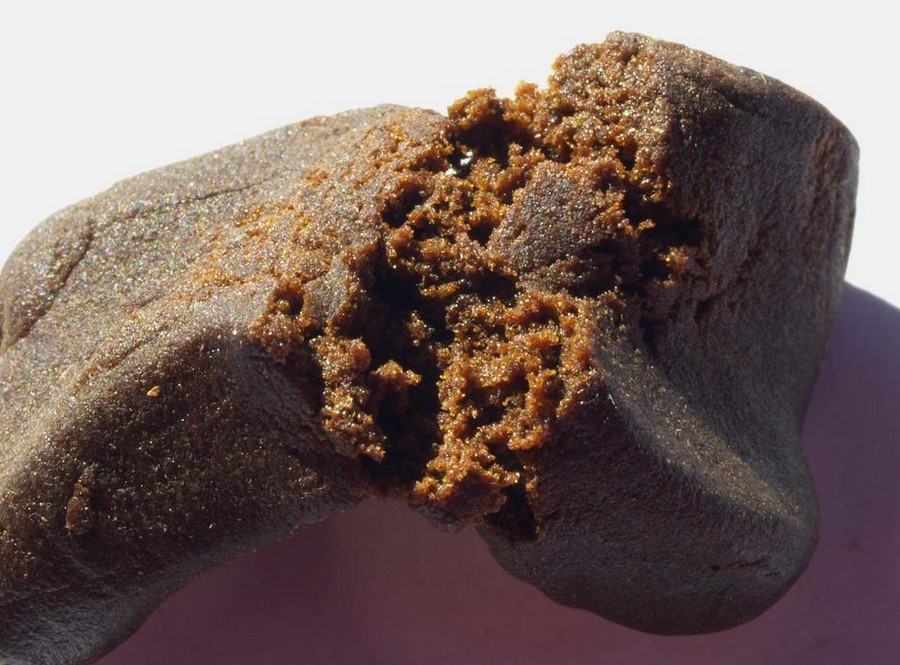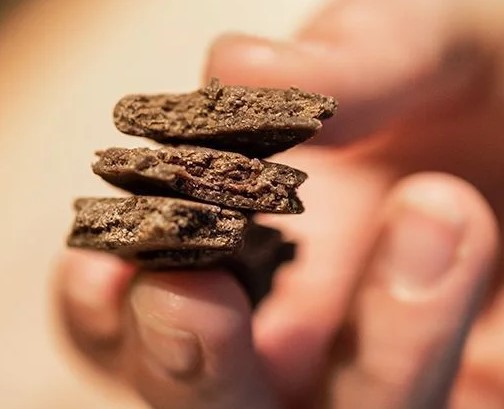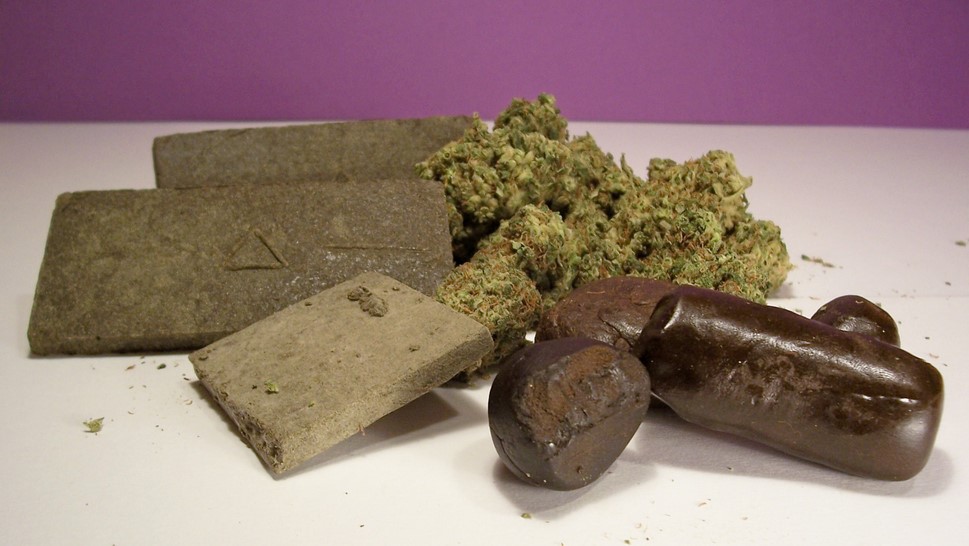Habibi hash, or Habibi hashish, is a cannabis plant’s resin glands compressed or pressed together to form brick, slab, or rolled components. Habibi hashish has a chocolate brown, greenish khaki, or sandy brown coloration.

More about Habibi hash
The most common way to consume hashish is by smoking it. Habibi hashish may be prepared in a variety of ways, but the basic operations include removing the resin, or trichomes, from a cannabis plant and repeatedly compressing them to form a hard, solid piece. It’s likely one of the oldest types of cannabis concentrates; written texts dating back as far as the 12th and 13th centuries speak about Habibi hashish. The varied appearance and feel of Habibi hash are linked to its origin and production process.
Sieved Habibi hashish, which is produced in the Middle East and Central Asia from resin powder collected from cultivated and cured cannabis plants, is one example. Modern techniques utilize fine mesh or silk fabrics to physically sift and remove the trichomes from the plant material. To help refine the trichomes, sieves with varying pore sizes are used. The resultant powder, also known as kief, is then pressed and prepared as Habibi hash bars, slabs, or bricks with a flat, hard, or sometimes chalky appearance.

Habibi hash vs. weed: what’s the difference?
Habibi hashish and marijuana are both derived from the cannabis plant. The term “weed” is most often used to describe the unprocessed leaves of the plant, while “Habibi hash” refers to a concentrate extracted from the resin of the plant.
What makes Habibi hash different from other cannabis concentrates?
Habibi hash is the original concentrate. Except for being the world’s oldest cannabis concentrate, it is comprised of trichome glands, which contain many of the plant’s beneficial compounds. The cannabinoids, terpenes, and flavonoids in cannabis combine to create a synergistic effect that may have therapeutic benefits. Terpenes have also been found to improve the effects of THC, CBD, and other cannabinoids when used together. In a 2011 research published in the British Journal of Pharmacology by Dr. Ethan B. Russo on the entourage effect of cannabinoids and terpenes, he wrote about how these chemicals work together. Lab research has shown that flavonoids have anti-inflammatory and antioxidant qualities, which can be beneficial during the cannabis experience. Terpenes may improve and amplify the cannabis experience, and flavonoids have been found to have anti-inflammatory actions.
Another advantage of Habibi hash is that it’s a low-tech concentrate: it doesn’t require lab grade equipment or solvents to create.
The dry resin powder that’s generated and used to make sieved Habibi hash has a long shelf life. The dried resin powder gathered and used to make sieved Habibi hash can last for years if properly stored. When the kief is pressed into a slab or bar, the rate of deterioration increases. The trichome gland’s structure, which acts as a natural barrier against oxygen, moisture, and other factors that might damage potency and flavor before it’s pressed, provides an effective barrier against degradation when it’s pressed.
How do you consume Habibi hash?
Habibi hash is most often consumed by smoking it alone or together with flower. You may come across mentions of eating it, but marijuana edibles provide much tastier alternatives and are simpler to dose.
How to smoke Habibi hash

Add it to a bowl/joint
Adding Habibi hash to a bowl of flower in a bong, bubbler, or pipe will increase the potency and experiences.
It’s also possible to smoke Habibi hash in a joint. (If you’re doing this for the first time, it might be more convenient if you don’t use a rolling machine.) First, lay out your rolling paper and cover with a layer of ground flower before adding any Habibi hash. Chalkier, drier Habibi hash can either be crushed or chopped before being sprinkled over the flower during production. When heated, thicker, stickier Habibi hash becomes malleable and flexible. Tapping it gently between the palms of your hands might help you to warm it up. Form a thin snakelike shape out of it and place it on top of the blossom. Rolling the joint slowly and firmly, then fastening the edges is as simple as ever.
Hot knifing
Habibi hash can also be smoked on its own. “Hot knifing,” “knife hits,” and “knife tokes” are all terms for smoking Habibi hash in which two metal knives, typically butter knives, are heated on a hot surface such as an electric range’s coils. The blades are put on the hot surface until they become extremely hot or begin to glow red. A piece of Habibi hash is laid on the heated portion of the flat knife blade.
The second knife is placed over the Habibi hash, which aids in keeping it steady and increasing the burn rate, resulting in more smoke. When smoking begins to produce smoke, the smoker grasps a funnel-shaped instrument (such as a 2-liter soda bottle cut in half) with a tiny end (like a chopstick) to their mouth and places it over the knives to collect as much smoke as possible while breathing through their mouth.
Smoke in a pipe
Pipes can also be used to smoke Habibi hash. When smoking Habibi hash alone in a pipe, use a screen to keep the smoldering piece of Habibi hash from entering the pipe and getting inhaled. Screens are available as mesh stainless steel or titanium, as well as glass flowers or stars shaped screens. Place the screen in the bowl’s opening and a piece of Habibi hash on top. Heat it with a lighter or hemp wick until you see a steady stream of smoke emerging. Remove the heat and take a breath through the mouthpiece when done.
Dabbing
Habibi hash is no exception to the rule that marijuana concentrates are excellent for baking. Habibi hash, like all other cannabis concentrates and extracts, can be dabbed using a dab rig, which is a particular sort of water pipe. Drop a piece of Habibi hash onto the hot nail with a dab tool. Place a carb cap over the nail and breathe through the mouthpiece of the dab rig when you see steady wisps of smoke emerge.
Habibi hash vs. charas
A Habibi hash is a concentrate made from cannabis trichomes that has been extracted and purged of THC. Habibi hashish, on the other hand, is produced by separating and purging the trichomes from dried and cured cannabis using a sieving technique before machine or manually pressing them to form the final product.
Charas is another similar cannabis concentrate, although there are a few key distinctions. Charas, like sieved Habibi hash, utilizes trichomes from the cannabis plant that have been removed. The trichomes in question aren’t acquired from dried and cured cannabis; instead, they’re obtained from fresh, living plants via hand-rubbing.
Hand-rubbing is a method of collecting cannabis resin by rubbing the still-growing stalks of mature plants with both hands. The cannabis stalks produce a very sticky resin that readily adheres to the hands as they are repeatedly rubbed. Charas is formed when the collector rubs their hand together, rolling and pressing the resin between their palms into a rounded, smooth, and glossy ball called charas.
Hand-rubbing isn’t as productive as sieving. Because much of the resin drops to the ground or adheres to clothing and other parts of the plant when collectors rub the stalks, a lot of it is lost. Hand-rubbing is also an inefficient, manual operation that needs a significant amount of time, physical energy, and perseverance. Sieved Habibi hash needs far less time and effort to produce gram for gram.
Rubbed charas is less potent than sieved Habibi hash and spoils faster. The leaves and tiny stems of the cannabis plant are broken during the rubbing process, which mixes moisture, plant material, and other impurities into the concentrate. Contaminants reduce charas’ shelf life and potency, making it more difficult to transport across longer distances. Because Habibi hash is easier to produce, store, and transport than charas, it’s far more popular.
Charas, on the other hand, has a long history in cannabis and is an important component in several traditions and beliefs. Charas appears to have begun in South Asia, primarily India and Nepal. It also has a loose connection to Hinduism, particularly Shiva (also known as Siva), one of the three major Hindu gods.
Shiva is said to have brought cannabis, or ganja, from the Himalayas in the Vedas, ancient texts dating back as far as 1500 BCE. Shiva was also believed to have discovered a field of cannabis plants that were growing tall on one especially hot day and found it comforting and shielding from the hot sun. He is said to have consumed some of the leaves, which revitalized his energy and improved his mood. He found cannabis and its benefits, and he decided it was his favorite cuisine thereafter. He’s sometimes known as the Lord of Bhang, a fermented milk drink made with marijuana, spices, and often still prepared and consumed in India today.
Hindu customs that were once associated with cannabis and charas are still observed today, although neither is presently a legal drug in India or Nepal. Shiva’s birthday, MaHabibi hashivratri, is an annual Hindu holiday dedicated to the god Shiva that emphasizes turning away from darkness and into a state of peace, truth, and goodwill. The Night of Shiva (or The Great Night of Shiva) is the night before the beginning of the festival. Hindus, as well as Shaivites and Saivites — those who consider Shiva to be the Supreme Being — traditionally stay up all night to meditate, chant Vedic mantras, fast, and practice yoga throughout the night. Drinking bhang and smoking charas and flower from a chillum – a straight smoking pipe made of clay, stone, or other material – is also done during this period in order to aid with meditation, prayer, and heightened awareness.
Although rubbed charas and sieved Habibi hash are distinct products, they both include the same fundamental recipe: collecting and pressing the trichomes of cannabis for consumption.
